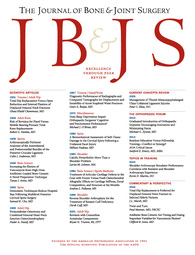
ARTHROPLASTY
PAI - with and without ACB - more effective than ACB alone for analgesia in total knee arthroplasty
This report has been verified
by one or more authors of the
original publication.
J Bone Joint Surg Am. 2018 Jul 5;100(13):1141-1146. doi: 10.2106/JBJS.17.01177
163 patients scheduled for total knee arthroplasty were randomized to an analgesic regimen which included either an adductor canal block alone, periarticular infiltration analgesia alone, or combined adductor canal block and periarticular infiltration analgesia. Patients were assessed for pain scores and opioid consumption over the first 3 days postoperatively. For pain score, significant differences were observed between the ACB+PAI group and the ACB alone group, with significantly lower levels in the ACB+PAI group on postoperative days (POD) 1 and 3. For opioid consumption, significant differences were observed for both the ACB+PAI group and PAI alone group compared to the ACB alone group, with significantly reduced opioid consumption on POD2 and 3 in the ACB+PAI group and the PAI alone group.
Unlock the full ACE Report
You have access to {0} free articles per month.Click below to unlock and view this {1}
Unlock NowCritical appraisals of the latest, high-impact randomized controlled trials and systematic reviews in orthopaedics
Access to OrthoEvidence podcast content, including collaborations with the Journal of Bone and Joint Surgery, interviews with internationally recognized surgeons, and roundtable discussions on orthopaedic news and topics
Subscription to The Pulse, a twice-weekly evidence-based newsletter designed to help you make better clinical decisions
Exclusive access to original content articles, including in-house systematic reviews, and articles on health research methods and hot orthopaedic topics
Or upgrade today and gain access to all OrthoEvidence content for just $1.99 per week.
Already have an account? Log in


Subscribe to "The Pulse"
Evidence-Based Orthopaedics direct to your inbox.
{0} of {1} free articles
Become an OrthoEvidence Premium Member. Expand your perspective with high-quality evidence.
Upgrade Now













































































